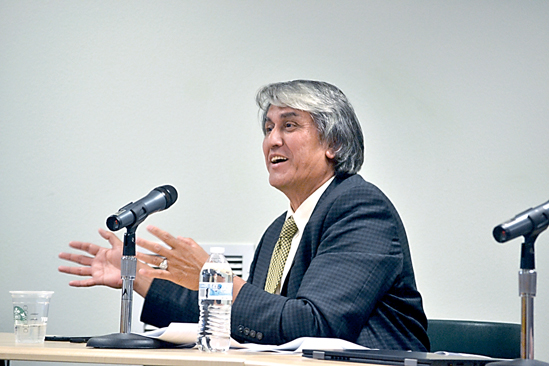SEQUIM — The results are in and a telephone survey about capital improvement projects in the Sequim School District shows voters would support a new construction bond, consultants say.
Ernest Flores, president of CFW Advisory Services LLC, summarized his company’s findings Monday in the Clallam Transit Center for the Sequim School Board and more than 30 attendees.
Of the 400 residents surveyed in June, Flores said about 68 percent with a +/- of 5 percent would support a $54 million bond, similar to the last proposal from February 2016.
Board directors meet again at 6 p.m. July 27, in the Clallam Transit Center, 190 W. Cedar St., to discuss the results and future plans for a bond discussion.
The district had asked for support to modernize and construct classrooms, replace aging portables, increase and upgrade teacher technology, and to improve student safety.
“[People] are willing to break open [their] checkbook if you are willing to show [them] the link between that facility and increasing academic achievement,” Flores said.
Past attempts
The school district has seen four failed school construction bond attempts in the past two years.
The first was a $154 million construction bond proposal in April 2014, a $49.2 million bond plan in February 2015, a $49.3 million plan in November 2015, and a $54 million bond proposal in February 2016.
Each of the three recent proposals gained at least 57 percent of the overall vote but fell short of the 60 percent supermajority required for passage.
When forming a question on the bond, Flores said the company looked at previous bond language. He added that key elements were not raising the tax rate any higher and looking at the scope of the projects.
“Most of the bonds that are successful point to what you’re going to do and not where you’re going to do it,” he said.
Flores said his staff also toured Sequim’s schools, reviewed listening sessions and met with staff about needed projects prior to creating and asking questions on their own.
Questions
Some of the questions ranged in highest support for rebuilding existing or new high school classrooms for science and math, engineering and tech courses (62.3 percent much more likely to favor) to replacing portable classrooms (60.5 percent).
Those surveyed were least likely to favor building an additional elementary gym for a multipurpose room to become exclusively a cafeteria (35.3 percent) and upgrading fields, play courts and assembly/performance spaces (33.5 percent).
When making improvements, 74 percent of residents said they’d support funding for all schools’ projects rather than one or some of the schools.
When asked to consider building a new elementary school, 63 percent said they’d prefer building on a site the district owns opposed to buying new property.
The survey results can be seen at www.sequim.k12.wa.us.
Residents, board speak
School Superintendent Gary Neal said the survey’s results echo comments heard at listening sessions and during coffee chats with residents.
“There’s a direct alignment between the results and word on the street,” he said.
Some attendees were skeptical of the findings, though.
Greg Madsen of Blyn felt 400 people was too small a sample and that some of his friends surveyed felt the survey was too long.
Lew Norris of Sequim agreed.
“I thought some of the questions were so lengthy that after four or five minutes I had to quit,” Norris said.
Board member Mike Howe said the sample size seemed in line with other surveys but that he had “serious concerns about how the questions were written.”
“I think they were leading,” he said. “I only saw them a week ago with the final results.
“The survey tells me we have a lot of work to do . . . Would the opposition ask the question the same way? If they won’t, then it’s probably biased.”
In April, board directors voted 3-1 with Howe opposed to approve a $15,500 contract with CFW Advisory Services LLC.
Howe said he shared the survey’s questions, despite being asked not to make them public, with a surveying company in Utah and they agreed with his analysis.
Neal said bias is expected in everything to a certain point.
“This scientific survey aligns with 70 pages of notes from listening sessions, from mostly naysayers,” he said.
“There’s a direct correlation with concerned citizens. This is not the only thing we’ve done [four listening sessions and five coffee chats since February]. We’ve spent hours listening to people.”
Board member Jim Stoffer, who has sat on facility committees before, said the one item that stood out to him most was opposition to moving a potential elementary school to the east.
“We are definitely going to have to find the real estate on the land that we have now,” he said.
He added that the “results validated what we’ve been bringing to the polls — people are supportive of education but not clear on an understanding of what a future facility would look like.”
________
Matthew Nash is a reporter with the Olympic Peninsula News Group, which is composed of Sound Publishing newspapers Peninsula Daily News, Sequim Gazette and Forks Forum. Reach him at mnash@sequimgazette.com.
